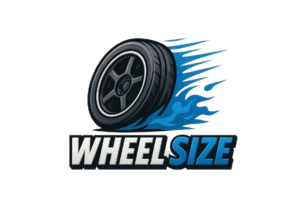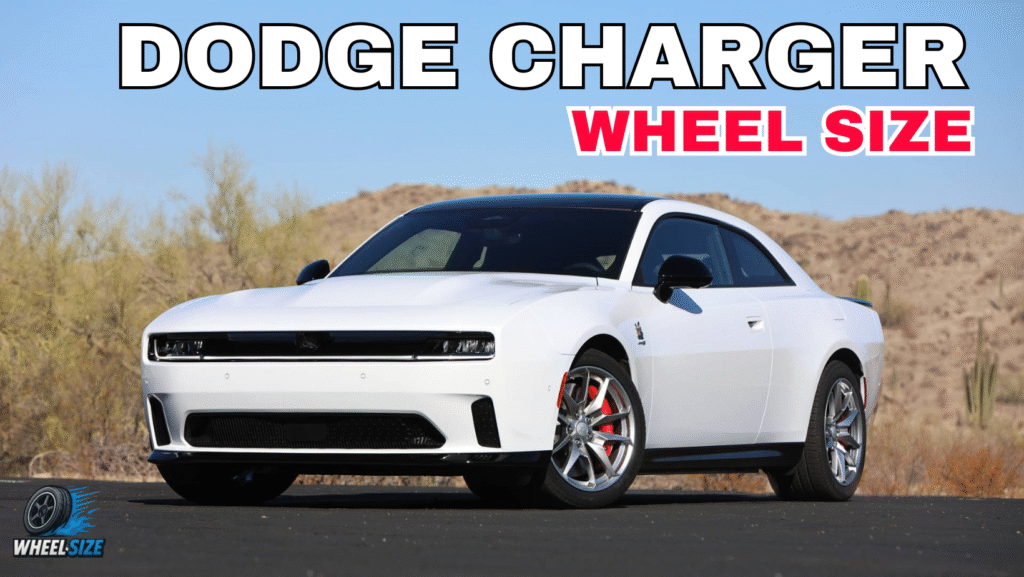Over the years, the Dodge Charger has taken on various guises, ranging from a sporty two-door muscle icon to a four-door powerhouse. Getting the proper wheel fitment has always been important, regardless of generation. It influences handling, braking, and even fuel economy, so picking the right rim size, tire size, bolt pattern, hub bore, and offset is more than just aesthetics. We’ll go over each Charger generation from 2015 to 1966 in this guide, dissecting the factory specifications and common upgrade options. You’ll know exactly what fits without rubbing, clearance problems, or throwing off the speedometer, whether you’re tuning a current Hellcat or restoring a classic. Let’s begin with the most recent models and proceed through time.
Wheel Fitment Basics
It’s critical to comprehend the essential fitting phrases before delving into each generation. The number of lug holes and spacing are determined by the wheel bolt pattern, which is measured in millimeters; the majority of contemporary Chargers utilize 5×115 mm. The diameter and width of the rims have an impact on performance and ride feel. The central hole size that guarantees a tight, well-balanced fit is called the hub bore. Tire size influences clearance, comfort, and grip, while offset regulates how much the wheel lies within or outside the fender. Complying with all of these specifications keeps the speedometer accurate, avoids rubbing against suspension parts, and ensures safe handling. Understanding these fundamentals will greatly facilitate understanding and comparing the specific specifications for each generation of charger.
Dodge Charger VII Facelift (LD) — 2015–2024
A sharper look and a wider range of performance options, including the Widebody, were introduced with the facelifted LD Charger. The hub bore is 71.5 mm, and the factory wheel bolt pattern is 5×115 mm. Base models have stock rims that measure 17 by 7 inches, while widebody variants have rims that measure 20 by 11 inches. For OEM wheels, offsets usually range from +18 mm to +24 mm. A Hellcat Widebody employs enormous 305/35R20 rubber, whereas a standard SXT may use 215/65R17 tires. Brake clearance is crucial for this generation; wheels made to accommodate huge Brembo calipers are needed for SRT and Widebody variants. If you’re upgrading, match the hub bore to keep the ride vibration-free and stay close to the standard offsets to prevent rubbing on the fender liners.
Dodge Charger VII (LD) Facelift [2015 .. 2024]
| Year | Center Bore | Bolt Pattern | Lug Nut Thread | Torque (Nm) | OEM Tire Size | OEM Rim Size | OEM Offset Range (mm) | Tire Pressure (Front / Rear, bar) | Aftermarket Wheel Size Range |
| 2015 | 71.6 mm | 5×115 | M14 x 1.5 | 176 | 215/65R17 98T235/60R17 98T235/55R18 100V235/50R19 97V245/45R20 99V | 7Jx17 ET247.5Jx17 ET247.5Jx18 ET247.5Jx19 ET248Jx20 ET24 | 22 – 26 | 2.12.12.32.32.3 | 17″–20″ |
| 2016 | 71.6 mm | 5×115 | M14 x 1.5 | 176 | 215/65R17 98T235/60R17 98T235/55R18 100V235/50R19 97V245/45R20 99V | 7Jx17 ET247.5Jx17 ET247.5Jx18 ET247.5Jx19 ET248Jx20 ET24 | 22 – 26 | 2.12.12.32.32.3 | 17″–20″ |
| 2017 | 71.6 mm | 5×115 | M14 x 1.5 | 176 | 215/65R17 98T235/60R17 98T235/55R18 100V235/50R19 97V245/45R20 99V | 7Jx17 ET247.5Jx17 ET247.5Jx18 ET247.5Jx19 ET248Jx20 ET24 | 22 – 26 | 2.12.12.32.32.3 | 17″–20″ |
| 2018 | 71.6 mm | 5×115 | M14 x 1.5 | 176 | 215/65R17 98T235/60R17 98T235/55R18 100V235/50R19 97V245/45R20 99V | 7Jx17 ET247.5Jx17 ET247.5Jx18 ET247.5Jx19 ET248Jx20 ET24 | 22 – 26 | 2.12.12.32.32.3 | 17″–20″ |
| 2019 | 71.6 mm | 5×115 | M14 x 1.5 | 176 | 215/65R17 98T235/60R17 98T235/55R18 100V235/50R19 97V245/45R20 99V | 7Jx17 ET247.5Jx17 ET247.5Jx18 ET247.5Jx19 ET248Jx20 ET24 | 22 – 26 | 2.12.12.32.32.3 | 17″–20″ |
| 2020 | 71.6 mm | 5×115 | M14 x 1.5 | 176 | 215/65R17 98T235/60R17 98T235/55R18 100V235/50R19 97V245/45R20 99V | 7Jx17 ET247.5Jx17 ET247.5Jx18 ET247.5Jx19 ET248Jx20 ET24 | 22 – 26 | 2.12.12.32.32.3 | 17″–20″ |
| 2021 | 71.6 mm | 5×115 | M14 x 1.5 | 176 | 215/65R17 98T235/60R17 98T235/55R18 100V235/50R19 97V245/45R20 99V | 7Jx17 ET247.5Jx17 ET247.5Jx18 ET247.5Jx19 ET248Jx20 ET24 | 22 – 26 | 2.12.12.32.32.3 | 17″–20″ |
| 2022 | 71.6 mm | 5×115 | M14 x 1.5 | 176 | 215/65R17 98T235/60R17 98T235/55R18 100V235/50R19 97V245/45R20 99V | 7Jx17 ET247.5Jx17 ET247.5Jx18 ET247.5Jx19 ET248Jx20 ET24 | 22 – 26 | 2.12.12.32.32.3 | 17″–20″ |
| 2023 | 71.6 mm | 5×115 | M14 x 1.5 | 176 | 215/65R17 98T235/60R17 98T235/55R18 100V235/50R19 97V245/45R20 99V | 7Jx17 ET247.5Jx17 ET247.5Jx18 ET247.5Jx19 ET248Jx20 ET24 | 22 – 26 | 2.12.12.32.32.3 | 17″–20″ |
| 2024 | 71.6 mm | 5×115 | M14 x 1.5 | 176 | 215/65R17 98T235/60R17 98T235/55R18 100V235/50R19 97V245/45R20 99V | 7Jx17 ET247.5Jx17 ET247.5Jx18 ET247.5Jx19 ET248Jx20 ET24 | 22 – 26 | 2.12.12.32.32.3 | 17″–20″ |
Dodge Charger VII (LD) — 2011–2014
There were many trim levels available for the muscular, four-door LD before the makeover. These years also make use of a 71.5 mm hub bore and a 5×115 mm bolt design. SE vehicles have Factory rims that measure 17 by 7 inches, while SRT8 cars have larger rims that measure 20 by 9 inches. Generally speaking, offsets range from +18 mm to +24 mm, depending on width. Entry-level tires measure 215/65R17, while SRT tires measure 245/45R20. If you’re updating your wheels, remember that a slightly wider setup, like a 275/40R20, can be achieved without significant changes thanks to the geometry of the fenders and suspension. Only ensure the offset stays within range during full steering lock to avoid protruding past the fenders or touching the strut tower.
Dodge Charger VII (LD) [2011 .. 2014]
| Year | Center Bore (mm) | Bolt Pattern | Lug Nut Thread | Torque (Nm) | OEM Tire Size | OEM Rim Size | OEM Offset Range (mm) | Tire Pressure (Front / Rear, bar) | Aftermarket Wheel Size Range |
| 2011 | 71.6 | 5×115 | M14 x 1.5 | 176 | 215/65R17 98T | 7Jx17 ET22 | 20–24 | 2.1 | 18″–22″ |
| 2012 | 71.6 | 5×115 | M14 x 1.5 | 176 | 235/55R18 98H | 7.5Jx18 ET24 | 22–26 | 2.3 | 18″–22″ |
| 2013 | 71.6 | 5×115 | M14 x 1.5 | 176 | 235/60R17 98T | 7.5Jx17 ET24 | — | 2.1 | 18″–22″ |
| 2014 | 71.6 | 5×115 | M14 x 1.5 | 176 | 235/50R19 97H | 7.5Jx19 ET24 | — | 2.3 | 18″–22″ |
| 2014 | 71.6 | 5×115 | M14 x 1.5 | 176 | 245/45R20 99V | 8Jx20 ET24 | — | 2.5 | 18″–22″ |
Dodge Charger VI (LX) — 2005–2010
This full-size sedan on the LX platform marked the return of the Charger name after nearly two decades. It has a 71.5 mm hub bore and a 5×115 mm bolt pattern. Depending on the trim, stock rim diameters range from 17×7 to 20×9 inches. The typical range of factory offsets is +18 mm to +22 mm. The range of tire sizes is 215/65R17 to 245/45R20. Because of the LX’s ample wheel well room, you can frequently accommodate a staggered layout with tires up to 295 wide, such as 20×9 in front and 20×10 in back, as long as the offset is done correctly. Before installing aftermarket rims, ensure that the calipers have enough clearance because SRT8 vehicles are equipped with larger brakes. Tighter offset control is necessary for lower automobiles to avoid rubbing when compressed.
| Year | Center Bore (mm) | Bolt Pattern | Lug Nut Thread | Torque (Nm) | OEM Tire Size | OEM Rim Size | OEM Offset Range (mm) | Tire Pressure (Front / Rear, bar) | Aftermarket Wheel Size Range |
|---|---|---|---|---|---|---|---|---|---|
| 2005 | 71.6 | 5×115 | M14x1.5 | 176 | 215/65R17, 235/60R17, 235/55R18, 235/50R19, 245/45R20 | 7Jx17, 7.5Jx17, 7.5Jx18, 7.5Jx19, 8Jx20 | 22–26 | 2.1 / 2.3 | 20″–22″ |
| 2006 | 71.6 | 5×115 | M14x1.5 | 176 | 215/65R17, 235/60R17, 235/55R18, 235/50R19, 245/45R20 | 7Jx17, 7.5Jx17, 7.5Jx18, 7.5Jx19, 8Jx20 | 22–26 | 2.1 / 2.3 | 20″–22″ |
| 2007 | 71.6 | 5×115 | M14x1.5 | 176 | 215/65R17, 235/60R17, 235/55R18, 235/50R19, 245/45R20 | 7Jx17, 7.5Jx17, 7.5Jx18, 7.5Jx19, 8Jx20 | 22–26 | 2.1 / 2.3 | 20″–22″ |
| 2008 | 71.6 | 5×115 | M14x1.5 | 176 | 215/65R17, 235/60R17, 235/55R18, 235/50R19, 245/45R20 | 7Jx17, 7.5Jx17, 7.5Jx18, 7.5Jx19, 8Jx20 | 22–26 | 2.1 / 2.3 | 20″–22″ |
| 2009 | 71.6 | 5×115 | M14x1.5 | 176 | 215/65R17, 235/60R17, 235/55R18, 235/50R19, 245/45R20 | 7Jx17, 7.5Jx17, 7.5Jx18, 7.5Jx19, 8Jx20 | 22–26 | 2.1 / 2.3 | 20″–22″ |
| 2010 | 71.6 | 5×115 | M14x1.5 | 176 | 215/65R17, 235/60R17, 235/55R18, 235/50R19, 245/45R20 | 7Jx17, 7.5Jx17, 7.5Jx18, 7.5Jx19, 8Jx20 | 22–26 | 2.1 / 2.3 | 20″–22″ |
Dodge Charger V (L-body) — 1982–1987
This version was a significant shift from the original Charger muscle, which was a small, L-body hatchback with front-wheel drive. Compared to later models, the wheel fitting here is much different. The hub bore is 57.1 mm, and the bolt pattern is 4×100 mm. The sizes of the factory rims were 13×5 and 15×6 inches. Offsets, which were normally +35 mm to +45 mm, were significantly higher than those of contemporary RWD chargers. Tire sizes were limited in stock, ranging from 165/80R13 to 195/50R15 for performance models like the Shelby Charger. Lightweight alloy wheels are ideal if you’re upgrading, and you’ll need to keep the offset high to avoid rubbing the strut. Wide wheels from today won’t fit without significant suspension changes.
| Year | Center Bore (mm) | Bolt Pattern | Lug Nut Thread | OEM Tire Size | OEM Rim Size | OEM Offset Range (mm) | Tire Pressure (Front / Rear, bar) | Aftermarket Wheel Size Range |
|---|---|---|---|---|---|---|---|---|
| 1982 | 57.1 | 4×100 | M12x1.5 | 175/75SR13 82S | 5Jx13 ET35 | 33–37 | 1.8 | 14″–16″ |
| 1983 | 57.1 | 4×100 | M12x1.5 | 175/75SR13 82S | 5Jx13 ET35 | 33–37 | 1.8 | 14″–16″ |
| 1984 | 57.1 | 4×100 | M12x1.5 | 175/75SR13 82S | 5Jx13 ET35 | 33–37 | 1.8 | 14″–16″ |
| 1985 | 57.1 | 4×100 | M12x1.5 | 175/75SR13 82S | 5Jx13 ET35 | 33–37 | 1.8 | 14″–16″ |
| 1986 | 57.1 | 4×100 | M12x1.5 | 175/75SR13 82S | 5Jx13 ET35 | 33–37 | 1.8 | 14″–16″ |
| 1987 | 57.1 | 4×100 | M12x1.5 | 175/75SR13 82S | 5Jx13 ET35 | 33–37 | 1.8 | 14″–16″ |
Dodge Charger IV (B-body) — 1975–1978
The Charger from the mid-to-late 1970s had decent fitting specs but was more of a personal luxury coupe than a pure muscle car. The hub bore is roughly 71.5 mm, and the wheel bolt pattern is 5×114.3 mm. The majority of stock rim diameters were 14×6 or 15×7 inches. These cars had a broad, planted appearance since the offsets were nearly zero (+0 mm to +10 mm). Bias-ply or early radial tire sizes were common, usually ranging from G78-14 to 225/70R15. It’s common to upgrade to period-correct modern 15×8 or 17×8 rims, but keep the offset at zero to prevent problems with suspension and inner fender clearance. For better cornering, this generation’s tires are a little broader.
| Year | Center Bore (mm) | Bolt Pattern (PCD) | Wheel Fasteners | Thread Size | OEM Tire & Rim | Offset Range (mm) | Tire Pressure (bar) | Aftermarket Wheel Size Range |
|---|---|---|---|---|---|---|---|---|
| 1975 | 71.6 | 5×114.3 (5×4.5) | Lug nuts | 1/2″ – 20 UNF | 195/75SR14 → 5.5Jx14 ET5 | 0 – 15 | 2.0 | 14″–17″ |
| 1976 | 71.6 | 5×114.3 (5×4.5) | Lug nuts | 1/2″ – 20 UNF | Same as 1975 | 0 – 15 | 2.0 | 14″–17″ |
| 1977 | 71.6 | 5×114.3 (5×4.5) | Lug nuts | 1/2″ – 20 UNF | Same as 1975 | 0 – 15 | 2.0 | 14″–17″ |
| 1978 | 71.6 | 5×114.3 (5×4.5) | Lug nuts | 1/2″ – 20 UNF | Same as 1975 | 0 – 15 | 2.0 | 14″–17″ |
Dodge Charger III (B-body) — 1971–1974
Wheel fitment here tends toward aggressive yet straightforward specs, as the Charger from the early 1970s was a mainstay of Mopar muscle. The hub bore is roughly 71.5 mm, and the bolt pattern is 5×114.3 mm. Typically, stock rims measured 14 by 6 or 15 by 7 inches, with offsets ranging from 0 to +10 mm. Later models had tires ranging from 235/60R15 radials to F70-14 bias-ply. For a more robust posture without clearance issues, many owners now update to 15×8 or 17×8 wheels with 245/60R15 or 255/50R17 tires. These cars’ rear wheel wells can accommodate a little wider tire, but to preserve adequate room for the fenders and leaf springs, you should keep the offset close to zero.
| Year | Center Bore (mm) | Bolt Pattern (PCD) | Wheel Fasteners | Thread Size | OEM Tire & Rim | Offset Range (mm) | Tire Pressure (bar) | Aftermarket Wheel Size Range |
|---|---|---|---|---|---|---|---|---|
| 1971 | 71.6 | 5×114.3 (5×4.5) | Lug nuts | 1/2″ – 20 UNF | 195/75SR14 → 5.5Jx14 ET5 | 0 – 15 | 2.0 | 14″–17″ |
| 1972 | 71.6 | 5×114.3 (5×4.5) | Lug nuts | 1/2″ – 20 UNF | Same as 1971 | 0 – 15 | 2.0 | 14″–17″ |
| 1973 | 71.6 | 5×114.3 (5×4.5) | Lug nuts | 1/2″ – 20 UNF | Same as 1971 | 0 – 15 | 2.0 | 14″–17″ |
| 1974 | 71.6 | 5×114.3 (5×4.5) | Lug nuts | 1/2″ – 20 UNF | Same as 1971 | 0 – 15 | 2.0 | 14″–17″ |
Dodge Charger II (B-body) — 1968–1970
Because of its appearances on TV and in movies, the second-generation Charger is undoubtedly the most well-known. It has a 71.5 mm hub bore and the same bolt pattern (5×114.3 mm). The original rims measured either 14×5.5 or 15×7 inches. Its broad rear haunches complemented the neutral offsets, which ranged from -6 to +6 mm. F70-14 bias-ply and 225/70R14 counterparts were among the stock tire sizes. For that vintage muscular rake, many contemporary restorations employ 15×8 or even 18×9.5 wheels with 275/60R15 rear tires. Excessive positive offset can push the wheels in too much, harming the stance and increasing the chance of suspension friction, as is the case with all older Chargers. To prevent inner wheelhouse contact, wide tires must be fitted carefully.
| Year | Center Bore (mm) | Bolt Pattern (PCD) | Wheel Fasteners | Thread Size | OEM Tire & Rim | Offset Range (mm) | Tire Pressure (bar) | Aftermarket Wheel Size Range |
|---|---|---|---|---|---|---|---|---|
| 1968 | 71.6 | 5×114.3 (5×4.5) | Lug nuts | 1/2″ – 20 UNF | 195/75SR14 → 5.5Jx14 ET5 | 0 – 15 | 2.0 | 14″–17″ |
| 1969 | 71.6 | 5×114.3 (5×4.5) | Lug nuts | 1/2″ – 20 UNF | Same as 1968 | 0 – 15 | 2.0 | 14″–17″ |
| 1970 | 71.6 | 5×114.3 (5×4.5) | Lug nuts | 1/2″ – 20 UNF | Same as 1968 | 0 – 15 | 2.0 | 14″–17″ |
Dodge Charger I (B-body)—1966–1967
The first Charger introduced the fastback muscle styling of Mopar. It had a 71.5 mm hub bore and a 5×114.3 mm bolt pattern. Offsets were usually about +0 mm, and stock rim diameters were typically 14×5.5 inches. By today’s standards, the original tire sizes were narrow, with bias-ply F70-14 or similar. A set of 15×7 or 15×8 wheels is ideal for improvements, and they look great with contemporary radial tires, such as 235/60R15, for a smooth yet aggressive ride. Going too wide on the front tires can increase steering effort because the front suspension geometry is more constrained than in subsequent generations. Compared to the thin factory setup, classic-style alloys or steel Magnum 500 wheels improve road traction while maintaining the historical appearance.
| Year | Center Bore (mm) | Bolt Pattern (PCD) | Wheel Fasteners | Thread Size | OEM Tire & Rim | Offset Range (mm) | Tire Pressure (bar) | Aftermarket Wheel Size Range |
|---|---|---|---|---|---|---|---|---|
| 1966 | 71.6 | 5×114.3 (5×4.5) | Lug nuts | 1/2″ – 20 UNF | 195/75SR14 → 5.5Jx14 ET5 | 0 – 15 | 2.0 | 14″–17″ |
| 1967 | 71.6 | 5×114.3 (5×4.5) | Lug nuts | 1/2″ – 20 UNF | Same as 1966 | 0 – 15 | 2.0 | 14″–17″ |
Choosing the Right Wheels
When choosing wheels for your charger, it’s important to consider fit, performance, and appearance. To prevent vibrations or dangerous mounting, start by precisely matching the hub bore and bolt pattern. Next, pick the rim size and offset that best fits your driving style. For example, aggressive postures require low offsets, while daily drivers find that moderate widths are more comfortable. To ensure adequate load capacity and speedometer accuracy, the tire size should match the rim without being overly stretched or bulging.
Common Fitment Mistakes to Avoid
Many Charger owners make mistakes by failing to pay attention to important fitting specifications. If you use the offset incorrectly, the tire might collide with the suspension or fender lip. Steering vibrations result from ignoring hub bore size. Under load, oversized tire widths that lack adequate clearance may rub. Furthermore, it is a risky beginner error to completely omit the proper bolt pattern. The functionality and safety of your charger rely on it. Measure twice, buy once.
Conclusion
The Dodge Charger’s wheel fitment history is as diverse as its design history, ranging from the svelte 14-inch wheels of the 1960s to the 20-inch forged alloys found on contemporary Hellcats. You may make confident upgrade decisions if you know your bolt pattern, rim size, hub bore, offset, and tire size. With the correct configuration, your Charger’s handling, posture, and road feel may all be improved while remaining safe and authentic to its roots.



